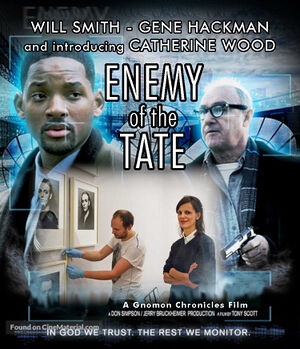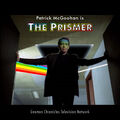Enemy of the Tate: Difference between revisions
No edit summary |
No edit summary |
||
| Line 4: | Line 4: | ||
<gallery> | <gallery> | ||
File:Night Fondue.jpg|link=Night Fondue|'''''[[Night Fondue]]''''' is a 1975 American neo-noir film about a Los Angeles | File:Night Fondue.jpg|link=Night Fondue|'''''[[Night Fondue]]''''' is a 1975 American neo-noir film about a Los Angeles health inspector (Gene Hackman) who uncovers a series of sinister events while searching for the missing teenage daughter of a former dairy farmer. | ||
File:The Prismer.jpg|link=The Prismer|'''''[[The Prismer]]''''' is a 1967 British television series about an unnamed British intelligence agent who is abducted and imprisoned in a gigantic prism, where his captors designate him as Number Six and try to find out why he abruptly ceased to split white light into its component colors. | File:The Prismer.jpg|link=The Prismer|'''''[[The Prismer]]''''' is a 1967 British television series about an unnamed British intelligence agent who is abducted and imprisoned in a gigantic prism, where his captors designate him as Number Six and try to find out why he abruptly ceased to split white light into its component colors. | ||
Revision as of 08:36, 3 October 2022
Enemy of the Tate is a 1998 British performative art comedy-thriller film about a group of corrupt Government Communications Headquarters (GCHQ) agents conspiring to kill Modern Art and the cover-up that ensues after a tape of the murder ends up in the possession of an unsuspecting Tate curator (Catherine Wood).
In the News
Night Fondue is a 1975 American neo-noir film about a Los Angeles health inspector (Gene Hackman) who uncovers a series of sinister events while searching for the missing teenage daughter of a former dairy farmer.
The Prismer is a 1967 British television series about an unnamed British intelligence agent who is abducted and imprisoned in a gigantic prism, where his captors designate him as Number Six and try to find out why he abruptly ceased to split white light into its component colors.
Get Pepin is a 1995 American gangster comedy revisionist history film about Pepin the Short (714 – 24 September 768), King of the Franks and the first Carolingian to become king.
Fiction cross-reference
Nonfiction cross-reference
External links
- Post @ Twitter (8 August 2022)
- https://twitter.com/GnomonChronicl1/status/1530305772839649282
- https://twitter.com/GnomonChronicl1/status/1529150458740318208
- A Bigger Splash: Interview with Catherine Wood - Jonah Westerman interviews Catherine Wood, curator of the exhibition A Bigger Splash, held at Tate Modern in 2012, about how the show represented the relationships between performance, performativity and painting.
- Enemy of the State (film) @ Wikipedia
- Tate @ Wikipedia
- GCHQ @ Wikipedia
- Enemy of the State - trailer @ YouTube
- Tate Modern Curator, Catherine Wood on Performance Art @ YouTube
- (nonfiction)
- Fiction (nonfiction)
- Art (nonfiction)
- Britain (nonfiction)
- Catherine Wood (nonfiction)
- 1990s (nonfiction)
- 1998 (nonfiction)
- Jerry Bruckheimer (nonfiction)
- Films (nonfiction)
- Gene Hackman (nonfiction)
- London (nonfiction)
- David Marconi (nonfiction)
- Tony Scott (nonfiction)
- Will Smith (nonfiction)
- Spies (nonfiction)
- Films



